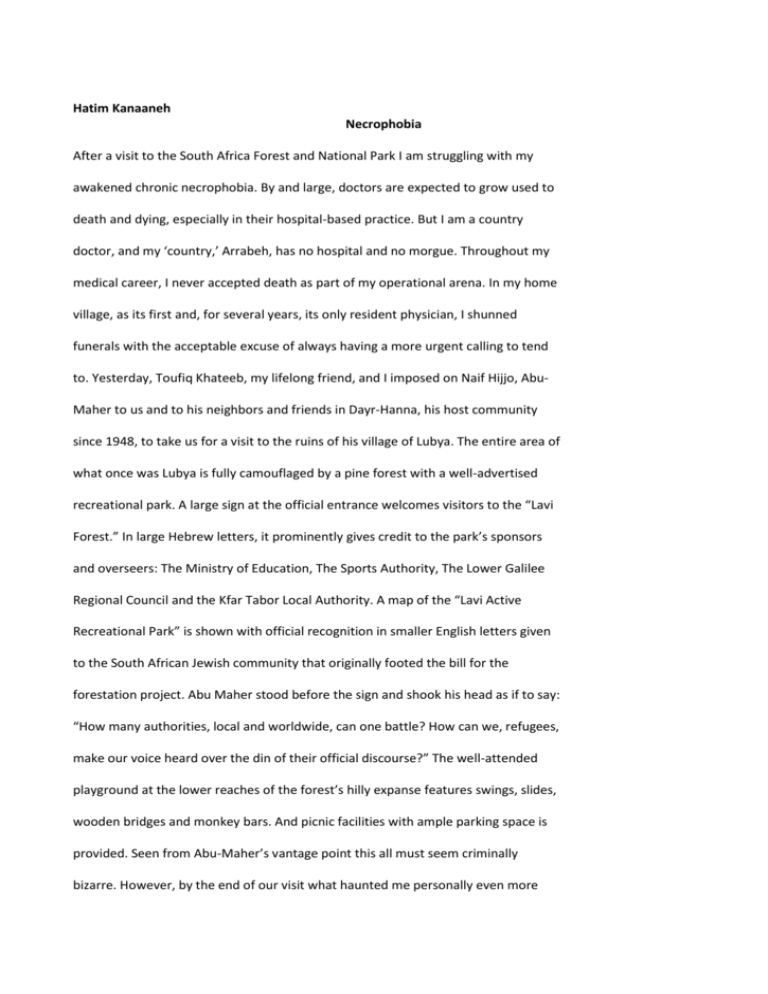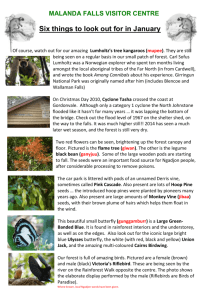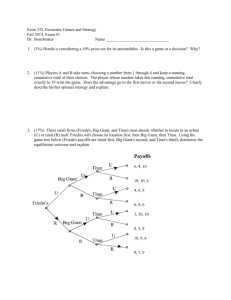Hatim Kanaaneh Necrophobia After a visit to the South Africa Forest
advertisement

Hatim Kanaaneh Necrophobia After a visit to the South Africa Forest and National Park I am struggling with my awakened chronic necrophobia. By and large, doctors are expected to grow used to death and dying, especially in their hospital-based practice. But I am a country doctor, and my ‘country,’ Arrabeh, has no hospital and no morgue. Throughout my medical career, I never accepted death as part of my operational arena. In my home village, as its first and, for several years, its only resident physician, I shunned funerals with the acceptable excuse of always having a more urgent calling to tend to. Yesterday, Toufiq Khateeb, my lifelong friend, and I imposed on Naif Hijjo, AbuMaher to us and to his neighbors and friends in Dayr-Hanna, his host community since 1948, to take us for a visit to the ruins of his village of Lubya. The entire area of what once was Lubya is fully camouflaged by a pine forest with a well-advertised recreational park. A large sign at the official entrance welcomes visitors to the “Lavi Forest.” In large Hebrew letters, it prominently gives credit to the park’s sponsors and overseers: The Ministry of Education, The Sports Authority, The Lower Galilee Regional Council and the Kfar Tabor Local Authority. A map of the “Lavi Active Recreational Park” is shown with official recognition in smaller English letters given to the South African Jewish community that originally footed the bill for the forestation project. Abu Maher stood before the sign and shook his head as if to say: “How many authorities, local and worldwide, can one battle? How can we, refugees, make our voice heard over the din of their official discourse?” The well-attended playground at the lower reaches of the forest’s hilly expanse features swings, slides, wooden bridges and monkey bars. And picnic facilities with ample parking space is provided. Seen from Abu-Maher’s vantage point this all must seem criminally bizarre. However, by the end of our visit what haunted me personally even more was our visit to Lubya’s major cemetery. We drove to the higher reaches of the forest through an unmapped semisecret road patronized mainly by Lubya’s native sons and daughters. We followed our guide on the dug-up road between huge eucalyptus trees, remnants of the British Mandate highway between Nazareth and Tiberius. We then turned up another narrow dirt road between barren terebinth trees and climbed up the hill, Lubya’s former residential area with its ruins now part of the extensive forest. Here we alighted and Abu-Maher led us on foot leaving his family at their regular picnic spot in the yard of their remembered ancestral home. It was Saturday, their day of rest, and a warm sunny day, a perfect chance for trans-generational nurturing of a sense of belonging to the land and of pride in who they once were and how they once lived as masters of their own fate in the midst of their inherited riches, not through the constant grind of the struggle to survive that a refugee’s life is. Some unemployed elder Lubyans prefer visiting the enchanted forest on Fridays when they pray at the sight of the mosque or in the cemetery. You need forty worshippers for a valid Friday group prayer. But, given the circumstances, Abu-Maher thinks that a dozen or less is acceptable. God knows proportionality. Even the tester in the traffic department is known to make exceptions. One faithful worshipper regularly performs his daily afternoon prayer in the solitude of the forest where his home once stood, drawing water for performing his ablutions from his family’s rainwater cistern. He drives over on his tractor from his “temporary residence” in Dayr Hanna. When he had to take the theoretical part of the test for his driving license he failed to recognize the traffic signal for railroad tracks. The tester wanted to fail him. But the man argued convincingly that there were no such tracks between Dayr Hanna and Lubya and getting to Lubya and back was the only reason he acquired his tractor. Abu-Maher constantly cautioned us to follow in his footsteps; he didn’t want us, two septuagenarians, to stumble on hidden ledges and fall. Every few steps he would reach down and clear the groundcover around a doorstep or the stump of an iron rod sticking out of a knocked down concrete pillar or horse tether. In one scenic spot, the concrete rubble has been cleared to reveal a well-preserved section of a tiled floor. It was the home of one of Lubya’s well-off leaders, Hassan Abu-Dhais, we are told. The spot has a fantastic view spanning the fertile plane to the north, shared in the old days with the farmers of Tur’aan and Nemrin. Abu-Maher pointed out a copse of olive trees at the foot of the hill across the plane identifying it as his family’s grove. To the west you can see the recently widened Golani Junction, a large MacDonald sign and the Golani War Museum. On a clear day, if you mentally eliminated all the pine trees, you could see clear across to the Golan Heights in one direction and to the Mediterranean in the other. It is a shame, our guide bemoaned, that one of Abu-Dhais’s sons was a collaborator who was brought back from Syria, granted citizenship and given a piece of his father’s land to grow terebinth trees in the hope of grafting them with pistachio, the very area we crossed to enter Lubya. In exchange he is reported to have signed away his family’s right to their extensive land holdings. The whole “pistachio graft scheme” failed and the collaborator son On our forest tour, unidentifiable rubble and cut limestone foundations of homes had to be expertly exposed by our native guide beneath the thick carpet of pine needles. Remnants of the proud and prosperous four-century-old Palestinian village were hard to hide. Deserted storage and animal husbandry caves dug in the side of the rocky hill, belied the virginity of the pine forest overhead. But the worst irksome reminders of the bustle of Lubya’s communal life, its memory still buzzing in the heads of all three intruders on the forest’s equanimity, were the tens of circular openings of water cisterns dug vertically in the rock, wide enough to admit a man’s torso but wider the deeper down one descended. Some of these rude reminders of the communal life their collected rainwater once nurtured were not all that modern. An expert hobby archeologist tells me that chemical analysis of the layers of plaster on the conical walls of such beers reveal traces of a dark blue dye in it. Could that be the famous Phoenician/Canaanite indigo dye? And what purpose did it serve other than reminding us who had dug all those manmade wonders that now pockmark the uniformly cushioned forest ground. And we had to skirt around the occasional cactus hedge, the hardiest of the preforest plants surviving the flora-cide scheme of the foresters. The choice of the foreign coniferous trees was not accidental, Abu-Maher thinks. It turns out that Israel’s world-famous “greening of the desert” had actually operated in reverse fashion. The cumulative acidity of the dropped foliage from the forest’s pine canopy was sufficient to kill nearly every native plant it shaded. It was an inventive yet natural way to lay claim to the conquered land in the name of the foreign newcomers. Even native olives, hardy enough to survive the fickleness of the region’s weather for several millennia, struggle to survive the forestation holocaust. I added my own conspiratorial explanation that the roots of the pine trees are probably the most efficient agents in decomposing the archeological remains of Lubya and the other 530 Palestinian towns and villages that Israel’s Military archives admit to having cleansed of their native residents and razed to the ground. This kindled our guide’s ire not only against the Zionist scheme but also against my ignorance: Lubya is his family’s live reality and not an archeological dig. Ironically, to back up his argument, he took us to the most valid testimony to Lubya’s days of progress and glory, its main cemetery. Abu-Maher spread out two large laminated maps he was carrying: one a pre-Nakba aerial map of Lubya and the other a map drawn from memory by some of its surviving sons and daughters in the Yarmouk refugee camp before their current Nakba there. Only the pain of losing one’s childhood home can guarantee such accurate reproduction, our guide thought. He then proceeded to point out the various residential neighborhoods of the village, their adjacent vegetable gardens, threshing grounds and fruit orchards and the maze of alleyways and footpaths. Every aspect of the multi-millennial human existence in Lubya has been fully submerged under the forest. The only remaining sign of life, indeed, is the cemetery. And, it is a well-utilized burial ground with nearly every square foot of its area marked as part of an oblong south-facing space surrounded by a low natural stone perimeter, the classic Islamic humble grave marking. Graves pretentious enough to have headstones or a cut stone boundary had those knocked down and the occasional family mausoleum had been ravaged. It seemed strange that such jealous guardians of the sanctity of the dead as Fox News, the BBC and The New York Times, who never fail to highlight anti-Semitic desecration of graves anywhere in the world in their headlines, would neglect to feature such atrocities committed in the heart of their favorite area of news coverage, the Jewish State, of all places. Perhaps their correspondents never look down when JNF guides lead them on such treks. Or perhaps they take literally Moslem statements when they say that their dead have ascended to heaven. On the inside walls of the largest such remaining structure someone had spray-painted an Arabic message to the occupants: “Don’t cry, Grandma! We shall return.” The childish artist left a heart for a signature. Abu-Maher knew of a less tender message that was inscribed in Hebrew on the grave of the late Muhammad Mfaddi. “It said: ‘Here lies a dog.’ We washed that off, of course. But you can still see it on Dr. Mahmoud Issa’s website. This fellow Lubyan professor and activist provided us with Obviously the cemetery had been intentionally spared the more deleterious effects of the pine forest. My chemistry knowhow is limited to the BA level. But I know the basics well. You can read my name etched in stone on the wall of the entrance to the University of Hawaii’s Bilger Hall as the top 1964 graduating student in Chemistry. That should be enough to authorize me to speculate on the possible effect of a pine forest on those buried in its midst. In time, the acidity of the forests groundcover of needles will penetrate the graves and dissolve their bones. And the voracious pine root systems would eventually leach out the released calcium and the organic matter. In the long run, they would break up the symbolic oblong stone markings. Could some god-fearing JNF official have made the decision not to plant pines right over the graves out of respect for the sanctity of the dead? Abu-Maher doesn’t believe so. God-fearing people don’t commit ethnic cleansing in the first place. And even if that were the case, it was the exception rather than the rule. After all, considerations of difference to the dead have not prevented the use of the large space to corral cattle over the years. It was the demands of Lubians like him that finally led the JNF a couple of years back to surround the cemetery with barbed wire. Now his Committee of Internally Displaced Palestinians badgers the Israeli authorities to allow it to replace that with a proper barrier to stop wild boars from entering it at night. And, indeed the graveyard is full of ruts from foraging wild pigs. The Israel Land Authority had hanged Many red warning signs on the fence, in Arabic this time, prohibiting entrance to the fenced off space. Like us, the boars We drive out of the forest bypassing the Jewish-only religious Kibbutz Lavie and skirt the other new settlement of Givat Avni. The red tile roofs of the latter’s fancier and more pretentious country homes, custom-made to house the better-off secular Russian immigrants, shine enticingly in the light of the setting sun. To the uninitiated it seems only logical that Abu-Maher, a well-off construction subcontractor, can quench his longing for his ancient home village by acquiring a residence in neighboring Givat Avni. It sits on the eastern edge of the undulating limestone hill that gave the ancient Canaanites who first chose to settle it the idea for its name and which was continuously inhabited for some four millennia before Israel erased it, forested its expanse and borrowed its name for the religious kibbutz across the valley in a silly ‘confuse the enemy’ game. Those first Canaanites must have viewed the smooth double rise of the hillock from Nemrin further north, another razed Palestinian village. To their primitive but fertile imagination, the double hillock, perhaps with Mount Tabor of transfiguration fame in the distance serving as its raised head, must have looked like a “Lioness” sitting in repose and glancing west eyeing the sunset in the Mediterranean across the plane of another of their majestic settlements, Saffuriyya. Does our Lioness now see the quarry, the massive wound Israel has dug in the back of another contemporary of hers to the right, the Turaan Mountain range? Or does it see or smell the stink hole Israel leaves smoldering in the environs of Saffuriyya and Nazareth to spew foul chemicals into the Galilean fresh sea breeze? Is our Lioness’s tail singed by the fumes of the other industrial zone in the direction of Hittin? I long for the moment when I would climb that Nemrin hilltop and let my own ‘Kanaanite’ imagination roam the horizons at will. That must have been the spot from which Saladin viewed the terrain when he allegedly complimented his Lubya hosts with the remark: “A lioness indeed.” Alas I am forever forbidden from such a pleasure. The Nemrin hill is a closed military zone and it is too late for me to enlist in “the most moral army in the world.” And AbuMaher’s theoretical ambition of residing in Givat Avni is never to be. Israel’s supreme court has put an end to such dreams with its infamous “admission committees” ruling. No committee of fresh Russian immigrants will accept a sordid Arab’s claim to their God-given land. Which gives me the urge to go back to that cemetery and ask some of its first residents if the good Lord had consulted with them before he promised their land, the land of the Canaanites, to the invading Israelites. But it was only 67 years ago that the people of Lubya got along famously with the Jews of Tiberius. It is not an ancient faith-based conflict by any stretch of the imagination. And I don’t want to ever enter that spooky space with its bone absorbing natural chemicals again. We are encouraged by our native guide to ignore the multiple warning signs along our path. We drive carefully over a series of mud pits between two stretches of barbwire fences, one encircling the exclusive settlement and the other barring us from entering its nature reserve on the opposite side. After all, the Galilee is Israel’s “natural set of lungs” And cultured immigrants chose to reside in it mainly for its bucolic clean environment. We stop at another scenic spot that proves Abu-Maher right again, the view worth the risky drive and the risk of entanglement in the barbed wire. The ground cover of the flat esplanade is rich with mouthwatering edible greens and with the first blooms of spring, a patch of chamomile with few audacious red poppies highlighting its bright yellow and creamy white palette. The inviting spring display belies the sudden drop of a rocky cliff on three sides into Lubya’s extensive Al-Hima plane. The sun is already hugging the western horizon. The clear spring weather permits its rays to light up the terrain in all directions. It sharpens the hilly boundary of Lubya’s former farming land into a ring-like rim. All of Palestine knew and subsisted on Lubya’s wheat, vegetables and fruits, we are reminded. But Abu-Maher doesn’t have an adequate explanation for the sexy- sounding local name of the cascading hills on whose peak we stand. Why and who came up with the playful name of Mount Dahidlini –Roll Me Over, I wonder? The horn of Hittin to the north imposes a whiff of historic ambiance and gravity. No, Abu-Maher insists, it was not in Hittin’s valley on the other side of the eons-old dormant volcanic crater, better known as the Horn of Hittin, that Saladin vanquished the crusaders. It was, Abu-Maher is sure, in ‘Sahel Damyeh’ way over in the southern end of the vast valley in front of us, which was once all Lubya’s own, that Saladin, with his Lubyan fighters, forced the Crusader invaders to thirst to death. It is the gushing Damyeh spring that the European colonialists of the time attempted in vain to access. And it was the copious amount of blood spilled in that battle that gave the spot its telling name, “Bleeding Plane.” Can we stop talking of death and dying, please? How about talking BDS for a change?










